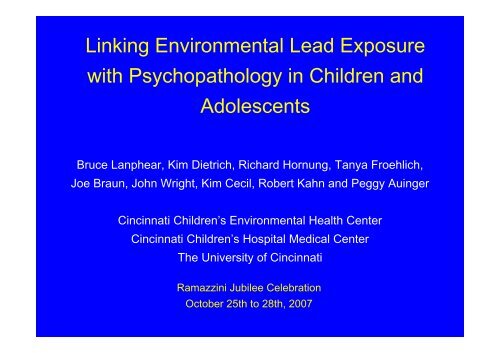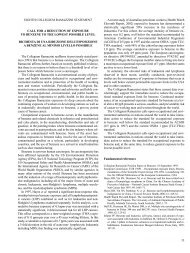download - Collegium Ramazzini
download - Collegium Ramazzini
download - Collegium Ramazzini
You also want an ePaper? Increase the reach of your titles
YUMPU automatically turns print PDFs into web optimized ePapers that Google loves.
Linking Environmental Lead Exposure<br />
with Psychopathology in Children and<br />
Adolescents<br />
Bruce Lanphear, Kim Dietrich, Richard Hornung, Tanya Froehlich,<br />
Joe Braun, John Wright, Kim Cecil, Robert Kahn and Peggy Auinger<br />
Cincinnati Children’s Environmental Health Center<br />
Cincinnati Children’s Hospital Medical Center<br />
The University of Cincinnati<br />
<strong>Ramazzini</strong> Jubilee Celebration<br />
October 25th to 28th, 2007
New Morbidities of Childhood<br />
Prevalence<br />
18<br />
16<br />
14<br />
12<br />
10<br />
8<br />
6<br />
4<br />
2<br />
0<br />
Autism<br />
Conduct<br />
Disorder<br />
Learning<br />
Disability<br />
ADHD<br />
Preterm<br />
Birth<br />
Boyle C, et al. Pediatrics 1994:93:399-403; Branum AM, et al. Paediatr Perinat Epidemiol<br />
2002;16:8-15; Hedley AA, et al. JAMA 2004;291:2847-50. Froehlich T, et al. Arch Pediatrics<br />
Adolesc Med 2007;161:857-864. Braun J, et al. (in preparation).
Background<br />
• Childhood lead exposure has been associated with<br />
delinquency, but questions remain about its association<br />
with criminal behaviors<br />
• Childhood lead exposure has been associated with<br />
features consistent with ADHD, but the relationship with<br />
diagnosis of ADHD is poorly defined<br />
• The estimated contribution of environmental lead<br />
exposure to child and adolescent psychopathology is<br />
poorly defined on a national level<br />
Needleman HL, et al. N Engl J Med 1979;300:689-95. Dietrich KN, et al. Neurotox<br />
& Teratol 2001;23:511-518.
Association of Blood Lead Levels and Self-<br />
Reported Delinquent Behaviors in Adolescents<br />
9<br />
8<br />
7<br />
6<br />
5<br />
4<br />
3<br />
2<br />
1<br />
0<br />
Prenatal PbB<br />
Average Childhood PbB<br />
78 Month PbB<br />
Lowest Low Medium High<br />
Blood Lead Level<br />
Dietrich KN, et al. Neurotox & Teratol 2001;23:511-518.
Linking Environmental Lead<br />
Exposure With Criminal<br />
Behaviors
Methods<br />
• Prospective birth cohort recruited from impoverished<br />
Cincinnati community from 1979 to 1984<br />
• Women were excluded if addicted to drugs of abuse,<br />
diabetic or had recognized psychiatric disorder<br />
• 250 children, age 18 to 24 years, were examined in<br />
these analyses<br />
• Criminal arrests were obtained from criminal justice<br />
records and coded by two independent reviewers<br />
• Minor offences, such as speeding or driving without a<br />
license, were excluded from these analyses
Number of Arrests by Childhood Lead Exposure:<br />
8 The Cincinnati Lead Study<br />
Number of Arrests<br />
6<br />
4<br />
Males<br />
2<br />
Females<br />
0<br />
0<br />
5<br />
10 15 20<br />
Six-Year Blood Lead Levels (µg/dL)<br />
25<br />
30<br />
* Accounting for birthweight, age, prenatal tobacco exposure, maternal age at delivery,<br />
maternal IQ, HOME Score. (Wright J, Dietrich KN, et al. submitted).
Reduction in Gray Matter by Mean Childhood<br />
Blood Lead Levels (n=157)<br />
Adjusted for child’s age, birth weight. Sex, gestational age, prenatal tobacco, prenatal<br />
alcohol, prenatal marijuana exposure, total intracranial volume, SES and HOME Inventory<br />
did not alter results (Cecil K, Brubaker C, Dietrich KN, et al. in preparation).
Reduction in Gray Matter by Childhood<br />
Blood Lead Levels and Subject’s Sex<br />
Men (n=83)<br />
Women (n=74)<br />
Adjusted for child’s age, birth weight. Sex, gestational age, prenatal tobacco, prenatal<br />
alcohol, prenatal marijuana exposure, total intracranial volume, SES and HOME Inventory<br />
did not alter results (Cecil K, Brubaker C, Dietrich KN, et al. in preparation).
Methods<br />
• National Health and Examination Survey, 2001-2004<br />
• The NHANES is a cross-sectional household survey of<br />
the non-institutionalized civilian population<br />
• 3,081 children, age 8 to 15 years, were used in these<br />
analyses<br />
• The Diagnostic Interview Schedule for Children (DISC)<br />
was used to assess for the presence of CD in the last<br />
year based on DSM-IV criteria. Parents were asked to<br />
report symptoms via telephone interview.
Risk of Conduct Disorder by Blood Lead Concentration<br />
in US Children, 8 to 15 years, NHANES 2001-2004<br />
Adjusted Odds Ratio<br />
10<br />
9<br />
8<br />
7<br />
6<br />
5<br />
4<br />
3<br />
2<br />
1<br />
0<br />
< 0.90 0.9 - 1.3 > 1.4<br />
Tertiles of Blood Lead Concentration (µg/dL)<br />
Adjusted for child’s age, sex, race and ethnicity, preschool attendance, serum ferritin,<br />
prenatal tobacco exposure and health insurance status. (Braun, et al. submitted)
Trends in Environmental Lead Exposure and<br />
Homicide Rate (per 100,000), United States<br />
Nevin R. Environmental Research 2000:83;1-22
Linking Environmental Lead<br />
Exposure with ADHD
Methods<br />
• National Health and Examination Survey 1999-2002<br />
• The NHANES is a cross-sectional household survey of<br />
the non-institutionalized civilian population<br />
• 4,704 children, age 4 to 15 years, were used in these<br />
analyses<br />
• The case definition of ADHD was based on parent<br />
report of doctor-diagnosis of ADHD by a physician or<br />
psychologist and ADHD medication use
Risk of ADHD by Blood Lead Levels in US Children,<br />
4 to 15 years, NHANES 1999-2002<br />
3<br />
Adjusted Odds Ratio<br />
2<br />
1<br />
0<br />
< 2 > 2<br />
Blood Lead (μg/dL)<br />
Adjusted for child’s age, sex, race and ethnicity, preschool attendance, serum ferritin, prenatal<br />
tobacco exposure and health insurance status. Braun J, et al. EHP 2006;17:500-505.
Risk of ADHD by Blood Lead Levels in US Children,<br />
4 to 15 years, NHANES 1999-2002<br />
Adjusted Odds Ratio<br />
5<br />
4<br />
3<br />
2<br />
1<br />
0<br />
2.0<br />
Quintiles of Blood Lead Concentration (µg/dL)<br />
Adjusted for child’s age, sex, race and ethnicity, preschool attendance, serum ferritin,<br />
prenatal tobacco exposure and health insurance status.
Population Attributable Fraction of<br />
Environmental Lead Exposure for Conduct<br />
Disorder and ADHD in US Children<br />
Exposed<br />
(%)<br />
AOR<br />
Population<br />
Attributable<br />
Fraction<br />
Excess<br />
Cases<br />
Conduct<br />
Disorder<br />
48%<br />
7.8<br />
.41<br />
230,000<br />
ADHD<br />
28%<br />
4.1<br />
.21<br />
290,000
Limitations<br />
• Studies did not account for all relevant risk<br />
factors or (e.g., parental psychopathology)<br />
• Diagnosis of ADHD and conduct disorder were<br />
based on parent report<br />
• Exposure misclassification, especially for<br />
prenatal tobacco and alcohol, which typically<br />
relied on maternal report
Summary<br />
• Mounting evidence linking low-level toxicant exposure<br />
with child and adolescent psychopathology<br />
• Large prospective birth cohort studies are needed to<br />
confirm results and explore GEi<br />
• Contemporary studies are needed to explore<br />
relationships at increasingly lower exposures<br />
• Need studies to examine specific environmental risk<br />
factors for endophenotypes and variants of ADHD,<br />
autism spectrum disorders and antisocial behaviors
Relative Risks of Arrests for Violent Crimes by<br />
Childhood Blood Lead Concentration<br />
Blood Lead Variable<br />
n<br />
Relative Risk for<br />
each 5 μg/dL<br />
(95%CI)<br />
Average Childhood<br />
250<br />
1.30 (1.03-1.64)<br />
Six-Year<br />
250<br />
1.48 (1.15-1.89)
Risk of Conduct Disorder by Prenatal Tobacco Smoke Exposure<br />
in US Children, 4 to 15 years, NHANES 1999-2002<br />
5<br />
Adjusted Odds Ratio<br />
4<br />
3<br />
2<br />
1<br />
0<br />
Unexposed<br />
Prenatal Tobacco Exposure<br />
Exposed<br />
Adjusted for child’s age, sex, race and ethnicity, preschool attendance, serum ferritin, blood lead<br />
concentration and health insurance status. Braun J, et al. EHP 2006;17:500-505.
Risk of ADHD by Prenatal Tobacco Exposure in<br />
US Children, 4 to 15 years, NHANES 1999-2002<br />
3<br />
Adjusted Odds Ratio<br />
2<br />
1<br />
0<br />
Unexposed<br />
Exposed<br />
Prenatal Tobacco Exposure<br />
Adjusted for race/ethnicity, sex, age, blood lead level, ferritin level, presence of a smoker in the<br />
home, preschool attendance, and insurance. Source: Braun J, et al. EHP 2006;114:1904-1909.





